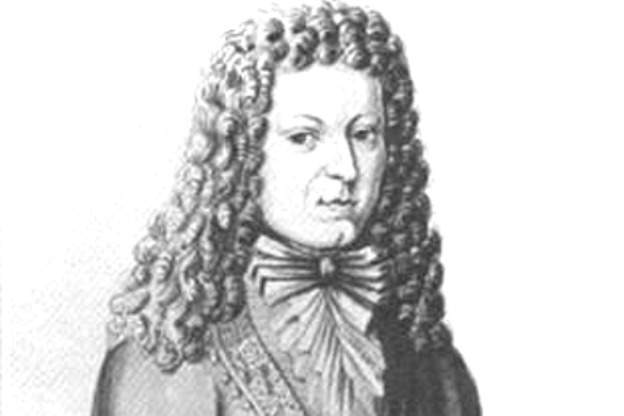
You may only know the composer Johann Kuhnau from passing mention. The immediate predecessor of J.S. Bach as cantor at the Thomasschule, who like Bach, spent a large part of his life and career in Leipzig, Kuhnau sometimes gets passed up or overlooked. But Opella Musica and the Camerata Lipsiensis is trying to change all that with their “Kuhnau Project.” A 2015 CPO release represents the first installment of an ongoing series devoted to Kuhnau’s complete sacred works.
Johann Kuhnau
While still a law student at the University of Leipzig in 1682, Kuhnau applied for the organ position at the Thomaskirche. He was turned down, but nonetheless made enough of an impression that when the post came open again two years later he was appointed by the town council. For the next four years Kuhnau continued to study law while earning a living as an organist.
Once Kuhnau finished his dissertation in 1688, he began to actively practice law. The next decade was a good one for Kuhnau. He got married and started a family that eventually included eight kids. His legal practice was going well, he published much of the keyboard music he wrote even as his reputation as an organist was gathering steam, wrote a satirical novel, and translated several French and Italian books into German.
St. Thomas cantor
In the meantime, the cantor at the Thomaskirche with whom Kuhnau worked was Johann Schelle. When Schelle died in 1701, Kuhnau took his place. His promotion from organist to Thomaskantor was the high point of his career and drew on his many talents as a musician, composer, scholar, and educator.
While Kuhnau published almost all of his keyboard works, he published almost none of his sacred music. That means that all those cantatas he composed for St. Thomas—by some impressive estimates, more music than Bach—were probably only performed in and around Leipzig. Unfortunately from those cantatas, only about 30 have been preserved in German libraries.
Bach's immediate predecessor
Since J.S. Bach was Kuhnau’s successor at St. Thomas, his music is the most obvious point of reference when exploring Kuhnau’s of the same genre. One difference between the two composers is that while Bach wrote many chorale cantatas, Kuhnau wrote only one or two. Chorale cantatas are works that use the text and usually the melody of a German chorale or hymn with which church-goers of the day would likely have been familiar.
The five-voiced cantata Welt adieu, ich bin dein müde (O World, farewell) scored with horns, oboes, flute, and strings is one of Kuhnau’s rare chorale cantatas. It is based on a harmonization by Johann Rosenmüller from 1648 and was eventually included as a standard tune in Lutheran hymnals.
This chorale cantata is one of Kuhnau’s later compositions, maybe even his last surviving one. Parts for this cantata survive in a 1719 version copied by Kuhnau’s students at St. Thomas, mostly his student Carl Gotthelf Gerlach. There are some parts missing that were reconstructed for this recording by David Erler.
Kuhnau’s setting of verse 4 of the hymn is a very beautiful trio for oboe, flute, and alto, but other movements highlight the horns.
Natural horns
The horns that Camerata Lipsiensis plays on this recording are built by Stephan Katte after period instruments by the Ehe family of instrument builders from Nuremberg. These particular horns are a bit smaller than the natural horns we may be accustomed to seeing and were probably played with trumpet mouthpieces.
Tristis est anima mea
A track that stands out in both style and orchestration on this CD is the motet Tristis est anima mea ad mortem. Curiously, it’s the only work on this CD that’s been recorded before. Even more curiously, the Tristis est anima mea might not even be by Kuhnau. Its only attribution is from the papers of Johann Gottfried Schicht, a much later 19th-century cantor at St. Thomas.
The writer of this recording’s liner notes, Michael Maul, suggests Dresden court composer Antonio Lotti as a more probably author of the piece. That said, until proven otherwise, the piece still bears Kuhnau’s name and receives a beautiful performance by Opella Musica.
Opella Musica and Camerata Lipsiensis
Opella Musica takes its name from the titles of two publications by the 17th-century composer Johann Schein. Opella is Latin for "small endeavour" and refers to the ensemble’s stated philosophy of “performing magnificent baroque music with very small forces to produce translucent textures.”
The instrumental ensemble with whom Opella Musica collaborates on this disc, Camerata Lipsiensis, is based in Leipzig and aim with their performances to carry on Leipzig’s centuries-old musical tradition.
In conjunction with Opella Musica and Camerata Lipsiense, Pfefferkorn Publishers in Leipzig have plans to issue the first complete scholarly edition of Kuhnau’s cantatas in time for his tercentennial in 2022. Between now and 2022 Opella Musica plans to devote much of their concert and recording efforts to the music of Kuhnau. We have much to look forward to!









